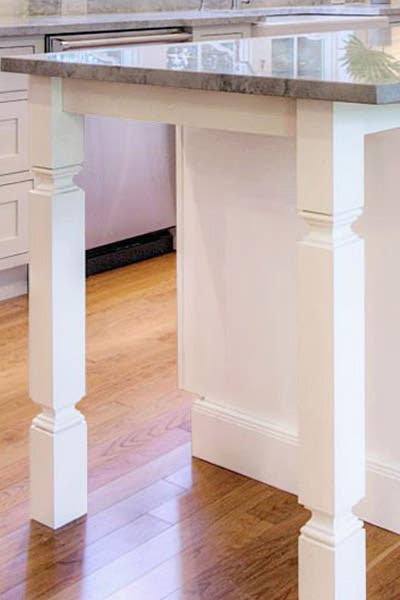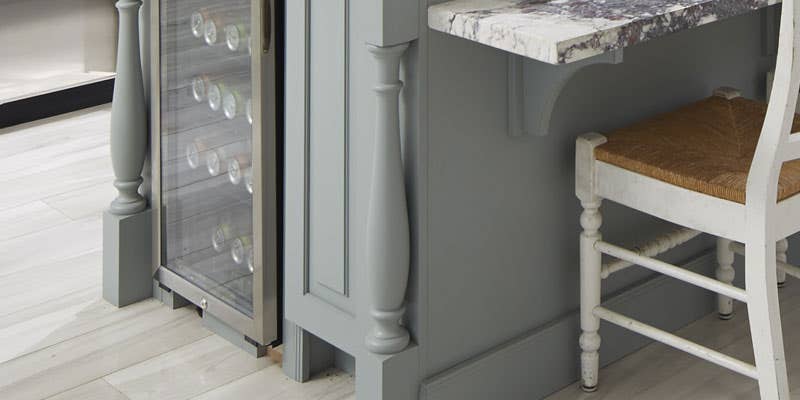Essential Variables to Think About When Picking Legs For Kitchen Island
Choosing the ideal legs for a kitchen area island entails a mindful assessment of multiple variables that can significantly affect both functionality and visual allure. As we discover these elements, it becomes clear that each decision can have far-reaching implications for the general cooking area experience.
Material Options
When picking legs for a kitchen island, recognizing the various product choices is necessary for achieving both aesthetic allure and structural honesty (Legs For Kitchen Island). The selection of product dramatically affects not only the longevity of the island but likewise its general style and capability
Steel legs, usually made from stainless steel or wrought iron, contribute a modern and industrial feeling while making sure toughness and stability. These products are immune to put on and can support substantial weight, making them suitable for bigger islands.
An additional choice is engineered products, like MDF or plywood, which can be extra cost-efficient while still using a variety of finishes. They may not provide the very same level of security as solid timber or steel. Legs For Kitchen Island. Last but not least, materials such as acrylic or glass can develop a modern look, though they may require extra support to ensure stability.
Eventually, the option of product for kitchen island legs need to line up with the wanted functionality and the total style of the kitchen.
Design and Layout

When considering design, the form and coating of the legs are vital. Conical legs can supply a sense of lightness and elegance, while thicker, much more durable legs can communicate strength and stability. In addition, the surface-- be it painted, stained, or all-natural-- must enhance the kitchen cabinetry and countertop products to develop a unified appearance.
Moreover, the design of the legs can also reflect individual preference. Custom-made or decorative legs, such as those including detailed carvings or unique geometric forms, can work as centerpieces, adding personality and individuality to the kitchen area. Inevitably, the best choice will certainly not just improve functionality however also raise the aesthetic charm, making the cooking area island a standout feature of the home.
Elevation Factors To Consider
Choosing the suitable height for kitchen island legs is essential, as it straight influences both performance and comfort. The common height for a kitchen island generally ranges from 36 to 42 inches, aligning with common countertop heights.

It is additionally necessary to account for users' heights and preferences. Personalizing the elevation can ensure a comfortable experience for all relative, making the cooking area island a much more functional and enjoyable room.
Weight Support
Guaranteeing sufficient weight assistance for kitchen island legs is vital for both safety and performance. The kitchen area island usually offers several functions, including cooking, dining, and extra storage space, necessitating a robust support framework. When selecting legs, it is critical to think about the total weight capability required based on the island's planned usage and the products that will certainly be positioned on it.
The option of product for the legs plays a considerable duty in their weight-bearing capacities. Strong wood, metal, and sturdy composites generally give superior stamina compared to lighter products. Furthermore, the design of the legs-- whether they are right, tapered, or have a pedestal type-- can affect their capacity to disperse weight efficiently throughout the framework.
Always seek advice from the maker's specifications regarding load restrictions to make certain that the legs can maintain the intended weight without endangering security. In summary, picking kitchen page island legs with appropriate weight support is vital for developing a safe and useful culinary room.
Setup and Maintenance
Appropriate setup and maintenance of cooking area island legs are crucial for guaranteeing durability and stability. This typically involves protecting the legs to the island base using suitable bolts, ensuring that the legs are degree and lined up.
When installed, regular upkeep is required to preserve the honesty and look of the legs - Legs For Kitchen Island. For wooden legs, regular cleansing with a moist cloth and application of ideal timber gloss can prevent wetness damage and preserve their finish. Metal legs might need a gentle cleaning solution to remove grease and grime, adhered to by a dry towel to avoid corrosion formation
Additionally, evaluate the legs frequently for indications of wear or damages, such as fractures or loose joints. Tightening up screws or bolts as needed can likewise prolong the life expectancy of the legs. By sticking to these setup and upkeep methods, house owners can ensure that their kitchen area island stays durable and visually appealing for many years ahead.
Verdict

Aesthetic coherence is vital in choosing the style and design of legs for a cooking area island, as these elements greatly affect the overall ambiance of the area. Conical legs can Click Here provide a sense of agility and style, while thicker, a lot more durable legs can communicate strength and security.Picking the suitable height for kitchen area island legs is critical, as it directly affects both performance and convenience. In summary, choosing my review here kitchen area island legs with ample weight assistance is important for producing a risk-free and functional cooking room.
In final thought, selecting legs for a kitchen area island necessitates cautious consideration of various factors, consisting of material options, style, elevation, weight support, and installation.